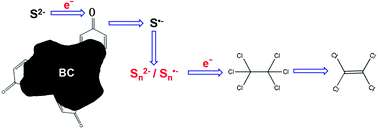Surface quinone-induced formation of aqueous reactive sulfur species controls pine wood biochar-mediated reductive dechlorination of hexachloroethane by sulfide†
Abstract
Understanding the mechanisms controlling the redox transformation of organic contaminants mediated by biochar is of great significance for application of biochar in remediation of contaminated soils and sediments. Here we investigated the mediation effect of a pine wood-derived biochar (P-char) in comparison with multiwalled carbon nanotubes (MCNTs) and graphite on the reductive dechlorination of hexachloroethane by sulfide. Upon normalization of the mediator's surface area, the reduction rate of hexachloroethane follows an order of P-char < MCNTs < graphite. Aqueous polysulfides and polysulfide free radicals were readily produced by reacting sulfide only with P-char, and the supernatant separated from the reaction system could account for 83.4% of the pseudo-kinetic rate constant of hexachloroethane mediated by P-char. In contrast, MCNTs and graphite had weak abilities to produce reactive sulfur species, and the supernatant exhibited very low reduction capability (<20.7%) of hexachloroethane. Electron paramagnetic resonance (EPR) analysis demonstrated that the surface quinone moieties on P-char induced the formation of polysulfides and polysulfide free radicals from sulfide by serving as one-electron acceptors. Consistently, polysulfides prepared by reacting elemental sulfur with sulfide showed much stronger reducing capability compared to sulfide. Thus, the mediation effect of P-char was dominantly attributed to the surface quinone-induced formation of reactive reducing sulfur species, whereas the mediation effect of MCNTs and graphite mainly stemmed from the enhanced electron transfer by the graphitized carbon. These results showed for the first time that surface quinone-induced formation of aqueous reactive sulfur species could control biochar-mediated reductive dechlorination of chloroorganic contaminants by sulfides.



 Please wait while we load your content...
Please wait while we load your content...